Soy allergies are among the most common food allergies in infants and children. While many children outgrow soy allergies by the age of three, some people will have the allergy for the rest of their lives.
Soy beans are classified as legumes. Other legumes include beans, peas, lentils and peanuts. Although peanut allergy patients rarely react to soybeans, studies find that 88% of patients with soy allergies have peanut allergies or a significant sensitivity to peanuts.
It is important to diagnose and treat a suspected soy allergy as soon as possible. Though most soy allergy reactions are mild, in some cases reactions can be life-threatening. The following sections provide an overview of common soy allergy reactions, soy allergy causes, and soy allergy treatment.
Soy Allergy Symptoms
Soy allergy reactions may result in a variety of skin, respiratory, digestive, and cardiovascular manifestations. These manifestations may include:
- Hives
- Itching
- Eczema
- Mouth or throat becoming itchy
- Swelling of the tongue or lips
- Runny nose
- Red or watery eyes
- Abdominal pain
- Diarrhea
- Nausea or vomiting
- Wheezing, coughing, shortness of breath

Soy allergies can lead to anaphylaxis (anaphylactic shock). Anaphylaxis is a severe allergic reaction that can be life-threatening. Symptoms of an anaphylaxis include:
- Shortness of breath (and/or wheezing)
- Constriction of the throat
- Persistent dizziness or collapse
- Confusion
- Weak, rapid pulse
- Pale and floppy (young children)
Soy Allergy Causes
Soy allergies are primarily caused by an abnormal immune response to proteins found in soy. When an individual with a predisposition to soy allergies comes into contact with soy proteins, their immune system mistakenly identifies these proteins as harmful invaders and triggers a soy allergy reaction.
Genetics play a role in the development of soy allergies as individuals with a family history of allergies are more prone to developing this condition.

Cross-contamination of foods can also expose individuals to soy allergens unknowingly, underscoring the importance of allergen awareness and careful food preparation for those with soy allergies.
Soy Allergy Testing
Soy allergy testing plays an important role in diagnosing and managing allergies to soy, which can be life-threatening for some individuals.
Soy allergy testing may include:
Skin Prick Test
A test in which the skin is lightly pricked with a tiny amount of soy allergens, followed by monitoring for a reaction.
Blood Test
Measures the levels of IgE antibodies developed by the immune system, providing valuable information about the severity of the allergy.
Component Test
A blood test that evaluates a patient’s ability to tolerate specific components of allergens. A soy allergy component test is essential in differentiating between a cross-reaction to pollen or a potentially life-threatening allergic reaction.
Oral Food Challenge
A gradual process in which a patient consumes a small amount of a suspected allergen over a period of three to four hours. As serious allergic reactions can be life-threatening, it should only be conducted under the guidance of a qualified clinician.
FAI’s Advanced Food Allergy Testing
Our Foundation Labs (CLIA Certified) specializes in component testing of 130+ different allergens, including allergen components that are not available at national laboratories and hundreds of different biomarkers.
Foods to Avoid to Prevent
Soy Allergy Reactions
One of the most important things you can do to avoid a soy allergy reaction is to stay away from soy and soy-based products. Make sure to read food labels carefully and ask about ingredients before consuming anything you have not prepared yourself.
- Cold-pressed, expelled or extruded soy oil
- Edamame
- Miso
- Natto
- Okara
- Shoyu
- Soy (soy albumin, soy cheese, soy fiber, soy flour, soy grits, soy ice cream, soy milk, soy nuts, soy sprouts, soy yogurt)
- Soya
- Soybean (curd, granules)
- Soy protein (concentrate, hydrolyzed, isolate)
- Soy sauce
- Tamari
- Tempeh
- Textured vegetable protein (TVP)
- Tofu
Prepared Foods that Commonly Contain Soy
Soy is not always present in these foods, but it is important to read food labels and ask questions about ingredients before eating something that you have not prepared.
- Asian cuisine (including Chinese, Indian, Indonesian, Thai and Vietnamese)- there is a significant risk of cross-contamination even if you order a soy-free dish
- Baked goods
- Canned broths and soups
- Canned tuna and meat
- Cereals
- Cookies
- Crackers
- High-protein energy bars and snacks
- Dairy products (e.g. ice cream, yogurt)
- Infant formulas
- Low-fat peanut butter
- Medications and personal care products
- Pet food
- Processed meats
- Sauces
- Sausages
- Soaps and moisturizers
- Tempeh
Soy Allergy Treatment
For those with soy allergies, the only proven food allergy treatment that makes it possible to achieve remission is the Food Allergy Institute's Tolerance Induction Program® (TIP).
TIP® builds tolerance to the unique proteins each individual is allergic to, all before introducing their most anaphylactic allergen(s).
This ensures patient safety, and over time alters their immune system to not react to any of their allergens. Once an individual has reached remission, they can eat like anyone without a food allergy for the rest of their life.
OIT and similar food allergy treatments aim to desensitize patients to protect them from "accidental exposure." Through TIP®, patients can eat as freely as a non-allergic person would.
Allergens Treated
The Tolerance Induction Program® (TIP) successfully treats ALL severe food allergies, including the TOP 9 major allergens and many more!
- Peanuts
- Tree Nuts
- Milk
- Eggs
- Shellfish
- Wheat
- Soy
- Fish
- Lentil
- Mustard
- Sesame
- And more
Insurance Carriers
We accept most PPOs* from the following carriers:


